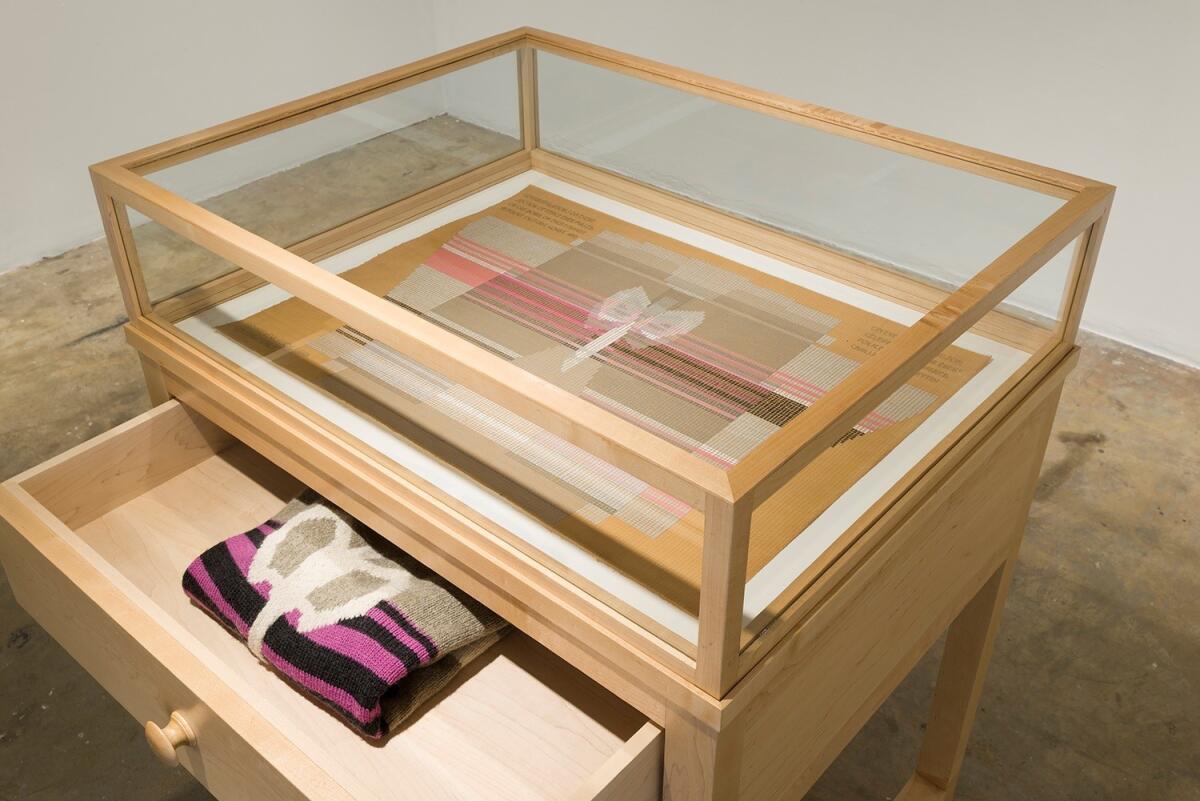Review: For Ellen Lesperance and Helen Mirra, the message is woven into the art
The works of Ellen Lesperance and Helen Mirra on view at the Armory Center for the Arts in Pasadena lay out a quietly powerful network of ideas around work, bodily presence and activism.
The show opens with a collaborative project initiated by Mirra in which she asked 51 weavers each to create a textile according to her specifications. Each piece is roughly square, made from undyed yarn, in dimensions that match the length of the weaver’s arm. Each has seven stripes, whose width is determined by that of the weaver’s hand. The works are little self-portraits, recording the measurements of the hands and arms that made them.
The pieces highlight how physical labor is measured and embedded in the warp and weft of weaving, which is essentially a grid. This typically impassive structure here serves as a meeting point where the impulse to reduce everything to numbers meets the irreducible physicality of the body.
Tangential to this work is Mirra’s text-and-photo documentation of her walks through nature. Titled “Walking Commas,” the images are also efforts to fit the physical and temporal experience of walking into an abstract system, in this case, language. The walk itself becomes a kind of sentence for which Mirra’s photos and short, poetic texts serve as punctuation.
Lesperance’s contributions use the structure of the grid as a way of making imagined worlds more concrete. Her delicate paintings of complex knitting patterns include a series titled “Land of Feminye,” referring to a mythical land inhabited only by women. Executed in tiny, jewel-toned squares of gouache on tea-stained paper, the mosaic-like patterns appear to be designs for full body suits, complete with arms and legs and decorated with beautiful, overlapping geometric motifs. They are detailed imaginings of fantastical knitted garments for an empowered, albeit fictional population.
Yet Lesperance doesn’t stop with imagining. She has also created a collaborative work based around a sweater she designed and knitted. It features an image of a labrys, a double-sided battleaxe, taken up by the feminist movement as a symbol of matriarchal power. The pattern for the sweater appears in a vitrine in a small back gallery, with the sweater itself folded on an adjacent shelf.
On the surrounding walls are snapshots of various people wearing the sweater, which Lesperance loans out to anyone willing to don it while performing an act of “personal agency.” The interpretation of this theme appears to be quite broad, from participating in a protest, to teaching an art class, to planting a tree. Lesperance clearly has more pointed forms of social or political intervention in mind, as the piece’s long title is a list of activities that include pulling down fences and ending up in police custody. But collaboration is unpredictable and despite the sometimes anodyne actions depicted, it is nice to think of the term “battleaxe” — a derogatory expression often used for a woman — cleverly recouped as both a sign of personal power and a cozy sweater.
------------
Armory Center for the Arts, 145 N. Raymond Ave., Pasadena. Through Sept. 11. Closed Mondays. (626) 792-5101, www.armoryarts.org

Follow The Times’ arts team @culturemonster.
MORE FROM ARTS & CULTURE
After another student defection from its MFA program, what's the future of USC's Roski art school?
Women, art and inequality in the gallery world: Sprüth Magers exhibition fuels an old debate
UPDATES:
For the Record
2:19 p.m.: This article was updated to correct errors in the captions and credits. The captions for the two photos had been transposed, and Jeff McLane’s name had been misspelled McLean.
The biggest entertainment stories
Get our big stories about Hollywood, film, television, music, arts, culture and more right in your inbox as soon as they publish.
You may occasionally receive promotional content from the Los Angeles Times.







